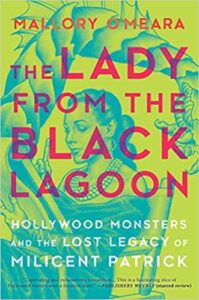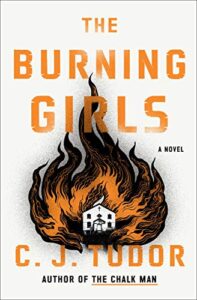( Bookshop.org | Amazon.com )
The Lady from the Black Lagoon: Hollywood Monsters and the Lost Legacy of Milicent Patrick by Mallory O’Meara
Hanover Square Press, 2019
ISBN-13: 9781335937803
Available: Hardcover, paperback. Kindle, Audible audiobook
When Mallory O’Meara discovered that one of her favorite movies, The Creature from the Black Lagoon, featured a monster designed by a woman, Milicent Patrick, she knew she had to find out more. Sadly, there was little information available about this elusive figure. Through her research, O’Meara learned much about Patrick’s contribution to The Creature from the Black Lagoon and her eventual disappearance from film history. O’Meara, herself working in the horror movie industry, “set out to right the wrong and in the process discovered the full, fascinating story of an ambitious, artistic woman ahead of her time.”
O’Meara’s book is well-researched, using primary archival resources and interviews as a basis for her work. She describes pushback she received from different parties in her introduction. Similar to asking the question, “why is there a Women in Horror Month?”, she was asked why she was searching so much for a woman who was denied her craft for decades. O’Meara spends the bulk of the book answering this question.
The book isn’t strictly a biography of Milicent, but also of those closest to her. O’Meara includes biographical information on Milicent’s parents, William Randolph Hearst, Bud Westmore, and other people who had been influential in Patrick’s life. Interspersed in the chapters are the author’s discussion of her discoveries and “aha moments”, such as finding Hearst Castle as a clue to unveiling more of Milicent’s life, her time at Glendale Junior College, her eventual dropping out to attend Chouinard Art Institute, and Walt Disney hiring her on in the animation department of his humble studio. Milicent worked as an uncredited model, developing her own sense of style, something her father disapproved of. The author does not hide that some of Milicent’s life choices led to heartache and agony, her own as well as others. O’Meara discusses Milicent crossing paths with the infamous Bud Westmore and her time designing the Gillman, Universal’s monster in Creature from the Black Lagoon. The author also provides some great information on the history of special effects, and the ongoing gender inequality in the film industry.
A major criticism I have about the content is O’Meara’s exaggerated lack of understanding of the research process. She discusses her struggles with the process and, thankfully, credits those who helped her by providing her with clues or pointing her in the right direction. She seemed to be unaware of databases, or how to conduct oneself in an archival room. While such things are undoubtedly unknown to some people, including her own ignorance and gasping, and telling the reader she probably annoyed others in the research room of the archives, would probably be best left out. However, O’Meara’s conversational style of writing is appealing, to a point, and makes the pace of the book go quickly. Recommended.
Reviewed by Lizzy Walker


![Wicked Women: An Anthology of the New England Horror Writers by [Trisha J. Wooldridge, Jane Yolen, Hillary Monahan, Lynne Hansen, Scott T. Goudsward]](https://m.media-amazon.com/images/I/51FnXkNEQ8L.jpg)




Follow Us!